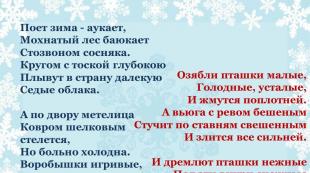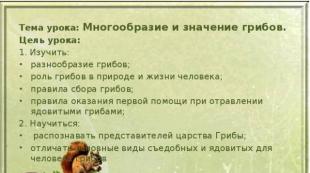Fire communication and fire alarm installations abstract. Fire alarm
The fastest and most reliable way to notify a fire is an electrical fire alarm (EPS).
EPS consists of the following basic parts: detectors installed in workshops, departments, warehouses, etc.; a receiving station located in the duty room of the fire brigade and an electrical wire network connecting the detectors (manual or automatic) installed at the facilities with the receiving station.
Given the dependence on the connection scheme of the detectors with the receiving station, the EPS should be beam (radial) or stub (ring).
AT ray EPS system (Figure 5 a), each detector 1 is connected to the receiving station 2 by two wires 6, forming a separate beam.
Figure 5. Scheme of the design of EPS systems:
1 - detectors-sensors; 2 - receiving station; 3 - backup power supply; 4 - power supply from the network; 5 - system for switching from one power supply to another; 6 - wires.
When a button on one of these manual call points is pressed or an automatic call point is triggered, a signal is generated at the receiving station indicating the beam number, ᴛ.ᴇ. place of fire. The receiving device is similar in principle to a telephone switchboard.
AT stub EPS system (Figure 5 b) all detectors 1 are connected to the receiving station 2 in series with one common wire 6. When the detector is triggered, except for the sound or light signal alarm, the number of the detector, the time and date of receipt of the signal are recorded on the tape of the receiving device, and the alarm signal is automatically broadcast to the central station. In the event of a network failure, it is marked at the station with a special signal. Recently, fire alarm installations with manual call points have been used less and less, and due to low reliability, the production of EPS loop systems has ceased.
The EPS of an enterprise or a separate area operates from manual and automatic detectors and is automatically connected to the city EPS. The most common detectors of the beam system are detectors of the PTIM type (maximum automatic heat detector), MDPI-028 (maximum differential fire detector), PKIL-9 (radiation push-button fire detector), etc.
Sensing elements there are automatic detectors: thermal - they respond to an increase in temperature (thermal detectors); light - react to open fire (sparks, flames) and smoke - react to the appearance of smoke.
Thermal detectors according to the principle of operation, they are divided into: maximum, triggered when a controlled parameter (temperature, radiation) reaches a certain value; differential, responsive to the rate of change of the controlled parameter; maximum-differential, reacting both to the achievement of a given value by the controlled parameter, and to the rate of its change. Thermal detectors, which, after triggering and establishing a normal temperature, return to their original position without outside intervention, are called self-healing.
Due to the simplicity of the design, the fusible heat detector (sensor) - DTL (Figure 6 b) has become widespread. As a sensitive element, it uses an alloy with a melting point of 72 ° C, which connects two springy plates. When the temperature rises, the alloy melts, and the spring plates, opening, turn on the alarm circuit.
Figure 6. Detectors
a, b - hot-melt detectors; c - ATIM thermal detector: 1 - bimetallic plate; 2 - base; 3 - stock; 4 - pin screw.
To instantly receive an alarm signal at the very beginning of a fire, the appearance of a flash of flame, smoke, etc. currently, low-response detectors with photocells, photon counters, ionization chambers, etc. are used.
For example, detectors of the SI-1 type, which react to the ultraviolet rays of an open flame, use semiconductor photocells. It is important to note that for the operation of such detectors, the appearance of an electric spark or match flame is sufficient. They do not work from lighting lamps, but must be protected from direct sunlight.
Smoke detectors are based on the use of photoelectric and ionization sensors.
Today, new fire detectors of the DIP type (DIP-1, DIP-2) are used, designed to detect smoke, operating on the principle of registering light reflected from smoke particles by a photodetector, and radioisotope smoke detectors of the RID type (RID-1, RID-6M), which have an ionization chamber as a sensitive element.
Fire alarm(PS) is a set of technical means, the purpose of which is to detect a fire, smoke or fire and notify a person in a timely manner. Its main task is to save people's lives, minimize the damage caused and preserve property.
It may consist of the following elements:
- Fire control panel (PPKP)- the brain of the entire system, controls the loops and sensors, turns on and off automation (fire extinguishing, smoke removal), controls annunciators and transmits signals to the control panel of a security company or a local dispatcher (for example, a security guard);
- Various types of sensors, which can respond to factors such as smoke, open flames and heat;
- Fire alarm loop (SHS)- this is a communication line between sensors (detectors) and the control panel. It also supplies power to the sensors;
- Annunciator- a device designed to attract attention, there are light - strobe lamps, and sound - sirens.
According to the method of control over the loops, fire alarms are divided into the following types:
PS threshold system
It is also often referred to as traditional. The principle of operation of this type is based on a change in resistance in the loop of fire alarm systems. Sensors can only be in two physical states "norm" and "fire". In case of fixing the fire factor, the sensor changes its internal resistance and the control panel issues an alarm signal on the loop in which this sensor is installed. It is not always possible to visually determine the place of drawdown, because. in threshold systems, an average of 10-20 fire detectors are installed on one loop.
To determine the malfunction of the loop (and not the state of the sensors), an end-of-line resistor is used. It is always installed at the end of the loop. When using fire tactics "PS triggering by two detectors", to receive a signal "Attention" or "probability of fire" additional resistance is installed in each sensor. This allows you to apply automatic systems fire extinguishing at the facility and the elimination of possible false alarms and damage to property. Automatic fire extinguishing starts only in case of simultaneous operation of two or more detectors.

PPKP “Granit-5”
The following FACPs can be attributed to the threshold type:
- series "Nota", manufacturer Argus-Spectrum
- VERS-PK, manufacturer VERS
- devices of the "Granit" series, manufacturer NPO "Siberian Arsenal"
- Signal-20P, Signal-20M, S2000-4, manufacturer NPB Bolid and other fire appliances.
The advantages of traditional systems include ease of installation and low cost of equipment. The most significant drawbacks are the inconvenience of maintaining a fire alarm and a high probability of false alarms (resistance can vary from many factors, sensors cannot transmit information about dust content), which can only be reduced by using a different type of fire alarm system and equipment.
Address-threshold system PS
A more advanced system is able to automatically periodically check the status of the sensors. Unlike threshold signaling, the principle of operation lies in a different algorithm for polling sensors. Each detector has its own unique address, which allows the control panel to distinguish them and understand the specific cause and location of the malfunction.
The Code of Rules SP5.13130 allows the installation of only one addressable detector, provided that:
- The PS does not manage fire alarm and fire extinguishing installations or fire warning systems of the 5th type, or other equipment that, as a result of launch, can lead to material losses and reduce the safety of people;
- the area of \u200b\u200bthe room where the fire detector is installed is not larger than the area for which this type of sensor is designed (you can check it according to the passport of the technical documentation for it);
- the sensor performance is monitored and in the event of a malfunction, a “fault” signal is generated;
- It is possible to replace a faulty detector, as well as its detection by external indication.
Sensors in the address-threshold signaling may already be in several physical states - "norm", "fire", "fault", "Attention", "dustiness" and others. In this case, the sensor automatically switches to another state, which allows you to determine the location of a malfunction or fire with an accuracy of the detector.

PPKP "Dozor-1M"
The following control panels can be attributed to the addressable-threshold type of fire alarm:
- Signal-10, manufacturer of airbag Bolid;
- Signal-99, manufacturer PromService-99;
- Dozor-1M, manufacturer Nita, and other fire appliances.
Address-analogue system PS
The most advanced type of fire alarm to date. It has the same functionality as the address-threshold systems, but differs in the way the signals from the sensors are processed. The decision to switch to "fire" or any other state, it is the control panel that takes it, and not the detector. This allows you to adjust the operation of the fire alarm to external factors. The control panel simultaneously monitors the status of the parameters of installed devices and analyzes the obtained values, which can significantly reduce the likelihood of false alarms.
In addition, such systems have an undeniable advantage - the ability to use any address line topology - tire, ring and star. For example, in the event of a break in the ring line, it will split into two independent wire loops, which will fully retain their performance. In star-type lines, special short-circuit insulators can be used, which will determine the location of a line break or short circuit.
Such systems are very convenient in maintenance, because. you can identify in real time the detectors that need to be purged or replaced.
The following control panels can be attributed to the analog addressable type of fire alarm:
- Two-wire communication line controller S2000-KDL, manufacturer NPB Bolid;
- A series of addressable devices "Rubezh", manufactured by Rubezh;
- RROP 2 and RROP-I (depending on the sensors used), manufacturer Argus-Spectrum;
- and many other devices and manufacturers.

Scheme addressable analog system fire alarm system based on PPKP S2000-KDL
When choosing a system, designers take into account all the requirements of the customer's technical specifications and pay attention to the reliability of operation, cost installation work and requirements for routine maintenance. When the reliability criterion for a simpler system starts to drop, designers move on to using a higher level.
Radio channel options are used in cases where laying cables becomes economically unprofitable. But this option requires more money for maintenance and maintenance of devices in working order due to the periodic replacement of batteries.
Classification of fire alarm systems according to GOST R 53325–2012
Types and types of fire alarm systems, as well as their classification are presented in GOST R 53325–2012 “Fire fighting equipment. Technical means of fire automatics. General technical requirements and test methods.

We have already considered address and non-address systems above. Here you can add that the first ones allow you to install non-address fire detectors through special expanders. Up to eight sensors can be connected to one address.
According to the type of information transmitted from the control panel to the sensors, they are divided into:
- analog;
- threshold;
- combined.
According to the total information capacity, i.e. the total number of connected devices and loops are divided into devices:
- small information capacity (up to 5 loops);
- medium information capacity (from 5 to 20 loops);
- large information capacity (more than 20 loops).
According to information content, otherwise, according to the possible number of issued notices (fire, malfunction, dustiness, etc.), they are divided into devices:
- low information content (up to 3 notifications);
- medium information content (from 3 to 5 notifications);
- high information content (from 3 to 5 notifications);
In addition to these parameters, systems are classified according to:
- Physical implementation of communication lines: radio channel, wire, combined and fiber optic;
- By composition and functionality: without the use of funds computer science, with the use of SVT and the possibility of its use;
- Control object. Control various installations fire extinguishing, smoke removal means, warning means and combined;
- Expansion possibilities. Non-expandable or expandable, allowing mounting in a housing or separate connection of additional components.
Types of fire alarm systems
The main task of the warning and evacuation management system (SOUE) is the timely notification of people about a fire in order to ensure safety and prompt evacuation from smoky premises and buildings to a safe area. According to FZ-123 "Technical regulations on the requirements fire safety” and SP 3.13130.2009, it is divided into five types.
The first and second type of SOUE
For most small and medium-sized objects, according to fire safety standards, it is necessary to install the first and second type of notification.
At the same time, the first type is characterized by the mandatory presence sound annunciator- sirens. For the second type, more “exit” light displays are added. A fire alarm should be triggered simultaneously in all premises with permanent or temporary stay of people.

Third, fourth and fifth type of SOUE
These types belong to automated systems, the launch of an alert is fully automated, and the role of a person in managing the system is minimized.
For the third, fourth and fifth types of SOUE, the main method of notification is speech. Pre-designed and recorded texts are transmitted, which allow the evacuation to be carried out as efficiently as possible.
In the 3rd type additionally, “exit” light indicators are used and the order of notification is regulated - first for the service personnel, and then for all the rest according to a specially developed sequence.
In the 4th type there is a requirement to have a connection with the control room inside the warning zone, as well as additional light indicators for the direction of movement. Fifth type, includes everything listed in the first four, plus the requirement that there is a separation of the inclusion of light indicators for each evacuation zone is added, full automation of the management of the warning system and the organization of multiple evacuation routes from each warning zone is provided.
For the purpose of timely notification of a fire, switching on fire extinguishing systems and calling fire brigades, a system is provided at enterprises fire communication and alerts.
Depending on the purpose, there are fire and security alarms for alerting fire brigade businesses or cities; dispatcher communications that provide control and interaction of fire departments with the administration of districts and city emergency services and operational radio communications, which "directly manages fire departments and crews when extinguishing a fire.
One of the types of fire communication is telephone communication. Each telephone set has a sign with telephone numbers for calling the fire brigade. Without fail, the premises of the fire post, duty personnel, dispatching communications, as well as other premises with personnel on duty around the clock are equipped with telephone communications.
Fire alarms are designed to quickly report a fire. Fire alarm systems are equipped with technological installations of increased fire danger, industrial and administrative buildings, warehouses. Fire alarms can be electrical or automatic.
An electrical fire alarm, depending on the connection scheme of the detectors to the receiving station, can be beam and loop (ring) (Fig. 4.15).
When installing a beam fire alarm system, each detector is connected to the receiving station by two wires, forming, as it were, a separate beam.
At the same time, 3-4 detectors are installed in parallel on each beam. When any of them is triggered, the receiving station will know the beam number, but not the location of the detector.
The most common detectors of the beam system are detectors of the PTIM type (maximum action heat detector), MDPI-028 (maximum differential fire detector), PKIL-9 (radiation push-button fire detector), etc.
The looped (ring) system when installing manual call points usually provides for the inclusion of approximately 50 detectors in series on one line (loop). Each detector, having a specific code and giving a signal to the station G, simultaneously gives information about its location. The fire brigade immediately leaves for the place where the detector is triggered.
Manual fire detectors can be installed both outside buildings on walls and structures at a height of 1.5 m from the floor or ground level and at a distance of 150 m from each other, and indoors - in corridors, passages, on stairwells, if necessary indoors. The distance between them should be no more than 50 m. They are installed one at a time on all landings of each floor. The installation site of manual fire detectors is illuminated by artificial light.
Surface areas where manual call points are to be placed are painted in White color with red border 20x50 mm wide (GOST 12.4.009). They should be included in an independent fire alarm loop or in conjunction with automatic fire detectors. To activate the electric fire alarm, break the glass and press the fire detector button.
At present, manual fire detectors of the brands IPR-1, IP5-2R, etc. are being produced.
Automatic detectors, i.e. fire alarm sensors are divided into thermal, smoke, light and combined.
Heat detectors (thermal detectors) are triggered when the temperature rises to a predetermined limit. They are recommended to be installed indoors. According to the principle of operation, thermal detectors are divided into maximum ones, which are triggered when a controlled parameter (temperature, radiation) reaches a certain value; differential, responsive to the rate of change of the controlled parameter; maximum-differential, reacting both to the achievement of a given value by the controlled parameter, and to the rate of its change.
Thermal detectors, which, after triggering and establishing a normal temperature, return to their original position without outside intervention, are called self-restoring.
Due to the simplicity of the design, the heat detector "howling fusible - DTL (Fig. 4.16) has become widespread. As a sensitive element, it uses an alloy with a melting point of 72 ° C, which connects two springy plates. When the temperature rises, the alloy melts and the plates, opening , turn on the signaling network.
Smoke detectors are used when a large amount of smoke and combustion products are released during the combustion of substances circulating in production. Smoke detectors are based on the use of photoelectric and ionization sensors. Widely used for this purpose are fire detectors of the DIP type (DIP-1, DIP-2), which operate on the principle of registering light reflected from smoke particles by a photodetector, and radioisotope smoke detectors of the RID type (RID-1, RID-6M), in which as The sensing element uses an ionization chamber.
Optoelectronic smoke fire detectors of the brands IP212-41M, IP212-50M, IP212-43, IP212-45, IP212-41M and combined with temperature sensor- IP212-5MS, IP212-5MK, IP212-5MKS, etc.
To instantly receive an alarm signal at the very beginning of a fire (when a flame, smoke, etc.) appear, fast-response detectors with photocells, photon counters, ionization chambers, etc. are currently used.
Smoke and heat fire detectors are installed on the ceiling, they can be installed on walls, beams, columns, suspended on cables under the coverings of buildings.
Light detectors are used when a visible flame appears during combustion. They can also be installed on equipment.
Combined detectors are used to protect high-reliability installations, when several fire effects can occur simultaneously.
The number of installed automatic fire detectors is determined by the area of the room, and for light detectors - and controlled equipment. Each point of the protected surface must be controlled by at least two automatic fire detectors.
Fire communication and signaling are of great importance for the implementation of measures to prevent fires, contribute to their timely detection and call fire departments to the place of fire, as well as provide management and operational management of work in case of fire.
security labor signaling protection lighting
Fire communication and signaling are carried out by technical means of communication: telephone, radio, electric fire alarm various kinds, the simplest means of communication (beeps of locomotives and steamers, bell ringing, hitting pieces of rails or other sonorous metal objects or parts).
For notification of a fire, the most widely used technical means of communication and fire alarm - telephone, electric fire alarm and radio.
Industrial enterprises, farms and other facilities with increased fire hazard, as a rule, are equipped with a direct telephone connection. For this purpose, a direct wire is laid from the object to the fire brigade, bypassing the telephone exchange, and two inductor telephones are installed.
To transmit a fire message from a city or other telephone to a central fire communication center (CPPS) from a city telephone exchange (GTS), special one-way telephone lines are laid. Telephone sets, as a rule, are equipped with special signs with a clear inscription of the telephone number of the fire department. If there is a telephone exchange (ATS), communication is carried out by dialing a specific number, and with a manual telephone exchange, by verbal demand: “Fire brigade!”
The most reliable and fastest means of communication for calling the fire brigade is an electric fire alarm, which consists of the following main parts: detectors installed in industrial buildings or on the territory of an industrial enterprise, farm or warehouse, designed to signal a fire; a receiving station with receiving devices that provide reception of fire signals and fix these signals; linear networks connecting detectors with receiving stations. The receiving station has optical and acoustic alarms.
Fire alarms can be divided into general, external and internal. The essence of the general signaling is that in case of fire, the alarm is given by a beep, a siren or a loud alarm bell.
The external fire alarm system is designed to establish communication between the enterprise and the city's fire organization to call the city's fire brigades. On ships of the navy and on large ships of the river fleet, radio communications are used for external signaling. In addition, steam whistles and sirens are used.
Internal signaling refers to the signaling that exists within a given enterprise or ship to call its fire brigade or squad. Of the large number of existing types of internal fire alarms, the most advanced is electrical (automatic and non-automatic). Depending on the connection scheme of the detector devices with the receiving station, the electrical signaling is divided into beam and loop.
According to the method of actuation, fire detectors are divided into manual (push-button) and automatic.
zvechatels of manual action (non-automatic). Depending on the method of connection with receiving stations, they are divided into beam and loop. Beam systems are called systems where each detector is connected to the receiving station with a pair of independent wires that form a separate beam. Each beam includes at least three detectors. When each of these detectors is pressed, the receiving station receives a signal indicating the beam number, i.e. place of fire.
The electric fire alarm of the loop system differs from the beam one in that the detectors are connected in series in one common wire (loop) laid in the ground or mounted on poles. The beginning and end of the wire are connected to the receiving station. Up to 50 detectors are included in one loop. The operation of this system is based on the principle of transmission by the detector of a certain number of pulses (detector code). The loopback alarm system is used, as a rule, on large industrial enterprises, warehouses, farms and other facilities.
Fire communications and alarms are organized to quickly and accurately receive messages about a fire, call additional forces in a timely manner, maintain communication with units on the way and at the fire site, communicate between units on fire, transfer information to officials about the progress of fire extinguishing, for everyday operational communications between departments and officials.
The central fire communication point is connected to the city automatic telephone exchange (ATS) by special lines.
Fire alarm systems are used to detect and notify the location of a fire. The combined fire and security alarm system performs the functions of protecting objects from unauthorized persons and fire alarms.
The main elements of the fire security and fire alarm: fire detectors, receiving stations, communication lines, power supplies, sound or light signaling devices (Fig. 15.2).
According to the method of connecting the detectors to the receiving station, beam (radial) and loop (ring) systems are distinguished (Fig. 15.3).
Rice. 15.2. Fire alarm installation diagram
 |
Rice. 15.3 Scheme of the device of electrical fire alarm systems:
a- radial (radial); b- loop (ring); 1 - announcers - sensors; 2 - receiving station; 3 - battery backup power supply; 4 - mains power supply; 5 - switching system from one power supply to another; 6 - wiring
Fire detectors can be automatic and manual. Depending on the activation parameter of the fire detector, they are: thermal, smoke, light, combined, ultrasonic and manual.
Heat detectors are triggered when the ambient temperature rises, smoke detectors - when smoke appears, light detectors - when there is an open fire, combined - when the temperature rises and smoke appears, ultrasonic - when the ultrasonic field changes under the influence of fire, manual - when turned on manually.
According to the design, fire detectors are of normal design, explosion-proof, intrinsically safe, sealed. According to the principle of operation, they are divided into maximum, triggered at a certain value of the absolute value of the controlled parameter, and differential, responding only to the rate of change of the parameter and triggered at a certain value.
Fire detectors are characterized by sensitivity, inertia, coverage area, noise immunity, design.
Automatic fire detectors send signals based on various principles of closing an electrical circuit (changes in the electrical conductivity of bodies, contact potential difference, ferromagnetic properties of materials, changes in the linear dimensions of solids, physical parameters of liquids, gases, etc.).
Thermal detectors of differential action of the DPS-OZ type operate on the principle of a different increase in thermo-EMF in blackened and silvered layers of thermocouples. They are triggered by a rapid temperature increase (at a speed of 30 ° / s), have an estimated service area of \u200b\u200bthe room up to 30 m 2 and can be used in explosive rooms.
For signaling from manual and heat detectors, receiving stations of the TLO-30 / 2M type (alarming, beam, optical) for 30 beams are used with a radial scheme for connecting detectors of the PIKL-7 type with the station.
The performance of multiple heat detectors is checked at least once a year with a portable heat source (150 W electric lamp with a reflector). The detector is operational if it is triggered no later than 3 minutes from the moment a heat source is brought to it.
Smoke detectors are divided into photoelectric and ionization. Photoelectric detectors (IDF-1M, DIP-1) operate on the principle of scattering of thermal radiation by smoke particles. Ionization - use the effect of weakening the ionization of the air interelectrode gap with smoke.
For example, alarm smoke fire installation type SDPU-1 is designed to detect smoke with subsequent supply of light and sound signals and control of external electrical circuits automatic devices firefighting. It is designed for 10 beams of the electrical network with 10 detectors connected to each beam. The 220 V network is insured by the battery supply.
Combined heat and smoke detectors have a sensitive element in the form of an ionization chamber (to respond to smoke) and thermistors (to respond to heat). The response temperature is 50-80 ° C. The estimated service area is 100 m 2.
Smoke and combined detectors are checked at least once a month with portable sources of smoke and heat. The detector response time is not more than 10 s. Install them in rooms in which there is no dust, vapors of acids and alkalis.
In light detectors, the photoelectric effect is used to detect a fire, i.e. conversion of light energy into electrical energy. In the premises where such detectors are installed, there should be no sources of ultraviolet and radioactive radiation, open flames, working welding machines etc. Light detectors are checked by the flame of a candle or match.
An ultrasonic detector (for example, Ficus-MP) is designed to spatially detect a fire and give an alarm. Such detectors are inertialess and serve a large area (up to 1000 m 2), but they are expensive and have the possibility of false alarms.
Thermal and lighting - in rooms with equipment and pipelines for pumping, producing and storing varnishes, paints, solvents, GZH, flammable liquids, for testing internal combustion engines and fuel equipment, filling cylinders with combustible gases.
Smoke - in rooms for electronic computers, electronic regulators, control machines of automatic telephone exchanges, radio equipment.
Thermal and smoke - installed in places where cables are laid, in rooms for transformers, distribution and switchboard devices of enterprises servicing cars, in which products made of wood, synthetic resins and fibers, polymeric materials, celluloid, rubber, textile materials, etc. P.









